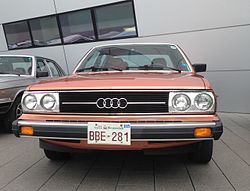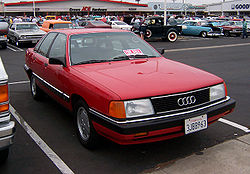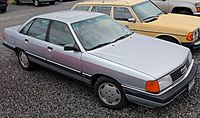Audi 5000
| Audi 5000 | |
|---|---|
| Production period: | 1978-1991 |
| Class : | upper middle class |
| Body versions : | Limousine , stretch limousine , station wagon |
| Successor: | Audi 100 / 200 |
The Audi 5000 was the version of the Audi 100 C2 and Audi 200 C2 (1976–1982) and its successor, the Audi 100 C3 (1982–1990), specially tailored to the requirements of the North American market .
Audi 5000 C2 (Type 43)
| C2 (type 43) | |
|---|---|
| Production period: | 1978-1982 |
| Body versions : | limousine |
| Engines: |
Otto engines : 2.1 liters (80–98 kW) Diesel engines : 2.0 liters (51–64 kW) |
| Length: | 4811 mm |
| Width: | 1763 mm |
| Height: | 1389 mm |
| Wheelbase : | 2677 mm |
| Empty weight : | 1300 kg |
General
The Type 43 was launched on the US market as the 5000 in August 1977, and in contrast to other markets only with the newly developed five-cylinder engines. This is where the new type designation 5000 came from, the appearance of which was based on the Audi rings and referred to the number of cylinders. The model replaced the Audi 100 C1 .
The C2 was adapted to the US market through local legal requirements: This affected both emissions and safety legislation. The five-cylinder had lower compression for the USA and could therefore also be operated with poorer fuel quality. As a result, however, a loss of performance had to be accepted; compared to the ECE version, the engine was throttled to 80 kW (108 PS). The injection engine with K-Jetronic was already equipped with a catalytic converter and, thanks to the modified transmission set-up, significantly more torque is now available in the lower speed range. A cruise control completes the package in order to take into account the US driving behavior (at a comparatively low and constant cruising speed over long distances). The bumpers had to withstand an impact of up to 5 mph undamaged and are therefore provided with deformation elements, but are also significantly larger. Side markers (amber lights in orange instead of the flashing light) and the side in the rear were prescribed for the US market in addition to the round sealed-beam lights. Instead of the three-point belts common in Europe, lap belts were installed in the rear. The color palette was less bright than in Europe and the equipment of the 5000 from model year 1978 corresponded roughly to the European GL version, which was poorly equipped for the US standards at the time. Audi never offered the 5000 as a station wagon (Avant) or two-door.
For model year 1979 there was the higher-quality Audi 5000 S with comfort-oriented equipment, including air conditioning as standard and leather upholstery was available. The "S" version quickly manifested itself as the most popular equipment variant, which soon took up around 90% of sales. A short time later, from the beginning of 1979, the five-cylinder diesel engine was also available in the USA; at the end of the 1970s, diesel engines were briefly popular in cars in the USA. It was available in both equipment versions (Audi 5000 Diesel and 5000 S Diesel), but could not be ordered in California because it could not comply with the local emissions regulations.
For the 1980 model year, the C2 was slightly revised: the rear lights were enlarged, which now incorporated the side position lights. The double headlights were now angular, they roughly corresponded to those of the European Audi 200 . The instruments were adapted to those of the Porsche 928 . The instrument panel and door panels have been changed, with better materials and fabrics. The massive bumpers were pulled around the corners of the vehicle. A turbo version "5000 S Turbo" was also offered; it was throttled to 98 kW (133 hp) in the USA model and only available with an automatic transmission. A turbo diesel was added to the range for the 1982 model year.
The Audi 5000 was initially quite successful in the USA and 133,512 units were sold. The vehicles were marketed through the joint sales channel Porsche + Audi .
In 1982 an Audi 5000 S was seen in the film ET - The Extra Terrestrial and in the television series Magnum .
Model years
Since the model change to the C3 in the US market was only planned for the model year 1984, all vehicles of the Audi 5000 C2 for the next US model year were manufactured in August to September 1982 shortly before the changeover to the C3. Their VIN identifies them as a 1983 model year (code letter "D"). The entire 1983 model year of the C2 was thus pre-produced for the US market. The parallel production of both model series (as with the predecessor) was to be avoided for logistical reasons. The C3 was not available in the USA until 1984.
| Model year | from | to | FIN |
|---|---|---|---|
| 1978 | Aug 77 | Jul 78 | 8th |
| 1979 | Aug 78 | Jul 79 | 9 |
| 1980 | Aug 79 | Jul 80 | A. |
| 1981 | Aug 80 | Jul 81 | B. |
| 1982 | Aug 81 | Jul 82 | C. |
| 1983 | Aug 82 | Sep 82 | D. |
Model variants
| Type | Audi 5000 Fuel Injection | Audi 5000 diesel | Audi 5000 Turbo | Audi 5000 Turbo Diesel |
|---|---|---|---|---|
| Engine code | WD (California: WE) | CN | WK | DE |
| Cubic capacity in cm 3 | 2144 | 1986 | 2144 | 1986 |
| cylinder | 5 | 5 | 5 | 5 |
| Performance in HP / KW | 108/80 | 70/51 | 133/98 | 87/64 |
| Mixture preparation | Bosch K-Jetronic | Distributor injection pump | Bosch K-Jetronic with turbocharging | Distributor injection pump m. Turbocharging |
| Dimensions Lim. (L / W / H) in mm | 4813/1768/1390 | 4813/1768/1390 | 4813/1768/1390 | 4813/1768/1390 |
| Tires | 185 / 70SR14 | 185 / 70SR14 | 205 / 60HR15 | 185 / 70SR14 |
| Empty weight in kg | 1210 | 1150 | 1260 | 1150 |
| V-max in mph (Autom.) | 103 (100) | 93 (-) | 109 (105) | |
| construction time | 1977-1982 | 1978-1982 | 1980-1982 | 1981-1982 |
| Production number | 160,650 |
Audi 5000 C3 (Type 44)
| C3 (type 44) | |
|---|---|
|
Audi 100 (USA, 1989–1991) |
|
| Production period: | 1983-1991 |
| Body versions : | Limousine , stretch limousine , station wagon |
| Engines: |
Otto engines : 2.1–2.3 liters (100–162 kW) |
| Length: | 4807 mm |
| Width: | 1814 mm |
| Height: | 1422 mm |
| Wheelbase : | 2687 mm |
| Empty weight : | 1260-1520 kg |
General
In the summer of 1983 the C3 (Type 44) was officially introduced in the USA . It had one of the most aerodynamic bodies of the time and was fully galvanized from model year 1986. He also wore massive bumpers and received angular double headlights, which were abandoned from the beginning of 1986. The new model immediately became a great sales success.
An inglorious chapter was a wave of lawsuits from Audi 5000 customers with automatic transmissions in the mid-1980s. It was triggered by a report on 60 minutes on CBS . Allegedly the car started by itself ("unintended acceleration"), which resulted in deaths. The alleged design flaw finally turned out to be an operating error ; some inexperienced customers had mixed up the gas and brake pedals. In addition, CBS had manipulated the report, but the image damage weakened Audi's US exports for many years. Ferdinand Piëch exacerbated this incident considerably in advance by commenting on it in a rather amused manner, which caused outrage in the USA. The Audi 5000 was now preceded by the reputation of an unsafe vehicle, and parking garages were sometimes blocked for this type.
For the 1989 model year, Audi even felt compelled to use the European nomenclature Audi 100 and Audi 200 instead of the designation “5000”. This model received a new dashboard and door handles. In order to maintain its position in the important US market, Audi entered the US racing business with the Audi 200 TransAM and the Audi 90 quattro IMSA GTO . After all, it would take 16 years for Audi to regain its earlier numbers in the USA. Years later , Toyota also faced a similar problem in the US market.
In 1986 an Audi 5000 C3 was featured in the film Ferris makes blue .
Against this background, the terms “I'm Audi 5000” or “I'm 5000!” ( Ice Cube , Eminem ) have established themselves in American hip-hop , which means something like “move quickly away”.
In 1991, the C3 model series in North America was replaced by the successor model Audi 100 C4 .
Web links
Individual evidence
- ↑ The Audi 5000 S from Mrs. Parry California Dreaming, at www.auto-motor-und-sport.de , accessed on July 30, 2015
- ↑ Audi 5000 - Urban Dictionary





